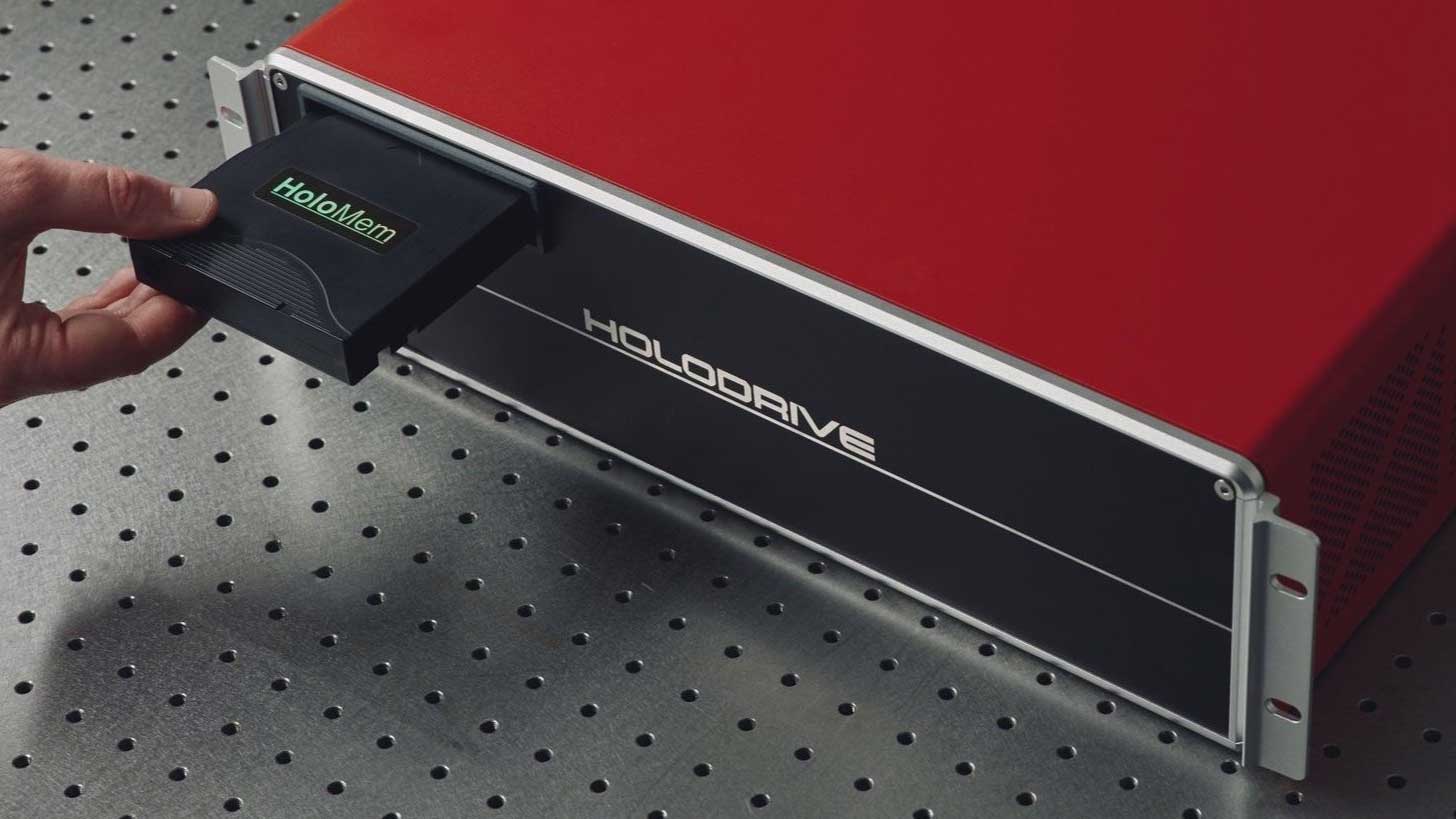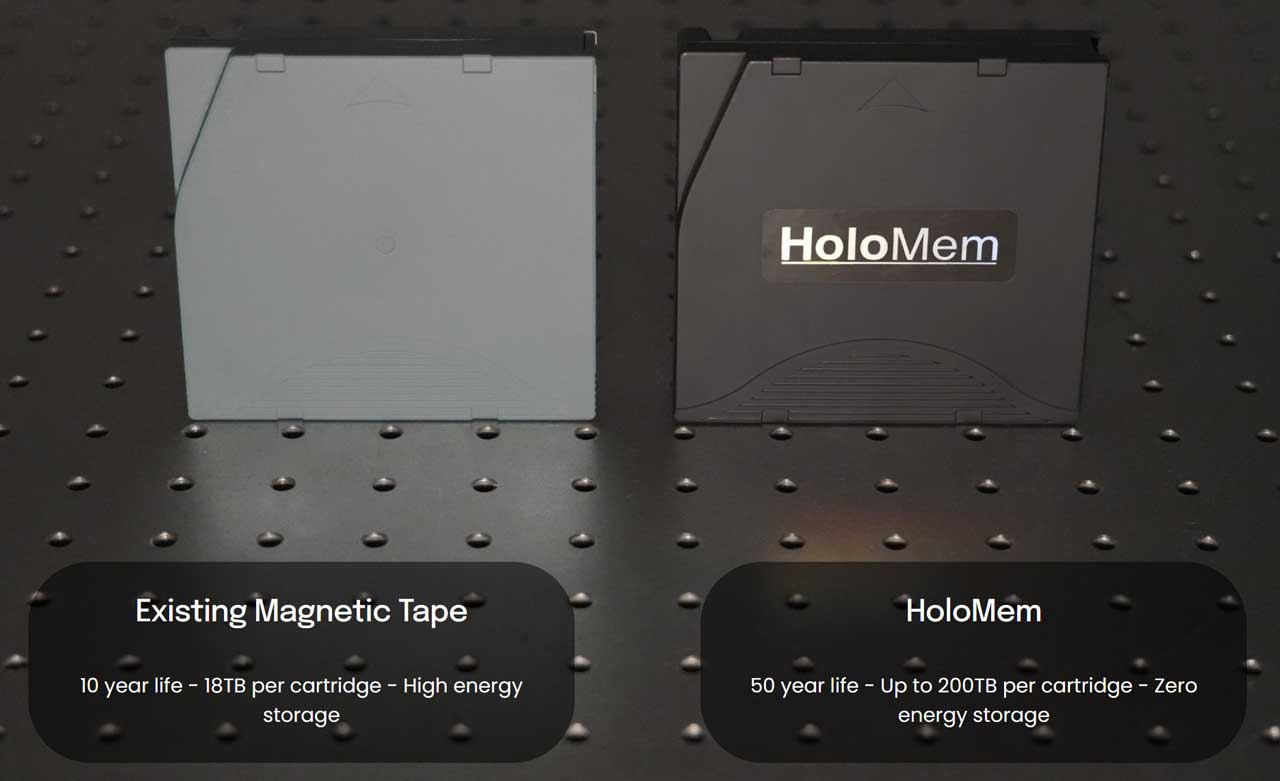Holographic ribbon aims to oust magnetic tape with 50-year life span and 200TB capacity per cartridge — HoloMem says optical ribbon-based carts work with some components of existing systems, reducing fricition
Startup also asserts the HoloMem system is a low-cost, lower energy choice.

Details behind HoloMem’s holographic tape innovations are beginning to come into clearer view. The UK-based startup recently chatted with Blocks & Files about its potentially disruptive technology for long-term cold storage. HoloMem is another emerging storage idea which relies on optical technology - to enable holographic storage. However, it cleverly melds the durability and density advantage of optical formats with a flexible polymer ribbon-loaded cartridge, so it can usurp entrenched LTO magnetic tape storage systems with minimal friction.
HoloMem key claims
According to the inventors of HoloMem, their new cold storage technology offers far greater capacity than magnetic tape, with a much longer shelf life, and “zero energy storage” costs. HoloMem carts can fit up to 200TB, which is more than 11x the capacity of LTO-10 magnetic tape. Also, the optical-based new tech’s touted 50-year life is 10x the life of magnetic tape.
Magnetic tape has been around for 70 years or more, so it isn’t surprising that a new technology has at last been designed as a serious replacement, beating it by all key metrics. However, the HoloMem makers have revealed quite a few more attractive features of their new storage solution, which could or should lead to success.

HoloDrive attractions
Probably one of the biggest attractions of HoloMem is that it minimizes friction for users who may be interested in replacing existing tape storage. The firm claims that a HoloDrive can be integrated into a legacy cold storage system “with minimal hardware and software disruption.” This allows potential customers to phase-in HoloMem use, reducing the chance of abrupt transition issues. Moreover, its LTO-sized cartridges can be transported by a storage library’s robot transporters with no change.
Another feather in HoloMem’s cap is the technology’s reliance on cheap and off-the-shelf component products. Blocks & Files says that the holographic read/write head is just a $5 laser diode, for example. As for media, it makes use of mass-produced polymer sheets which sandwich a 16 micron thick light-sensitive polymer that “costs buttons.” The optical ribbon tapes produced, claimed to be robust and around 120 microns thick in total, work in a WORM (write-once, read-many) format.
Thanks to the storage density that the multiple layers of holograms written on these ribbons enable, HoloMem tapes need only be around 100m long for 200TB of storage. Contrast that with the 1,000m length of fragile magnetic tape that enables LTO-10’s up to 18TB capacity.
Blocks & Files shares some insight gained from talking to HoloMem founder Charlie Gale, who earned his stripes at Dyson, working on products like robot vacuum cleaners and hair dryers. During his time at Dyson, Gale helped devise the firm’s multi-hologram security sticker labels. This work appears to have planted the seed from which HoloMem has blossomed.
Get Tom's Hardware's best news and in-depth reviews, straight to your inbox.

Rivals? Cerabyte and Microsoft Project Silica
Rival would-be optical storage revolutionaries like Cerabyte or Microsoft’s Project Silica may face far greater friction for widespread adoption, we feel. Their systems require more expensive read/write hardware to work with their inflexible slivers of silica glass, and will find it harder to deliver such easy swap-out upgrades versus companies buying into HoloDrives.
HoloMem has a working prototype now and is backed by notable investors such as Intel Ignite and Innovate UK. However, there is no official ‘launch date’ set. Blocks & Files says the first HoloDrives will be used at TechRe consultants, in its UK data centers to verify product performance, reliability, and robustness.
Follow Tom's Hardware on Google News to get our up-to-date news, analysis, and reviews in your feeds. Make sure to click the Follow button.

Mark Tyson is a news editor at Tom's Hardware. He enjoys covering the full breadth of PC tech; from business and semiconductor design to products approaching the edge of reason.
-
matthew warren LTO10 is 30TB native, and a conservative 75TB compressed, much much higher is possible depending on data type. LTO10 is also RW Many, and up to 1GB/s read/write speed, though generally closer to 400MB/s - whicch I notice was missed from the article so I can only assume holotape read/write speeds aren't worth mentioning.Reply -
HardwiredWireless Reply
Them I guess it's a good thing they are working on a much better system than the older, smaller LT010 finally.matthew warren said:LTO10 is 30TB native, and a conservative 75TB compressed, much much higher is possible depending on data type. LTO10 is also RW Many, and up to 1GB/s read/write speed, though generally closer to 400MB/s - whicch I notice was missed from the article so I can only assume holotape read/write speeds aren't worth mentioning. -
marsilies This is promising, but there's a few things that will limit adoption, especially by enterprises:Reply
It's an unproven tech by a new company. For something as valuable/critical as backups, you want something with a proven track record. Sure, the company claims 50 year lifespan, but who knows how long the tapes or drives will actually last?
It's a proprietary tech by a single company, as opposed to LTO, which is an "open" standard that multiple companies supply tapes and drives for. Being reliant on a single company keeping a product around for decades is a high-risk situation. I recently watched a Youtube video by MattKC called "How Frogger 2’s source code was recovered from a DESTROYED tape" about the struggles they had recovering a backup from a proprietary and long discontinued tape format, OnStream. It was a struggle to find a working drive and software that could properly read the backup, and that backup was only 24 years old. It doesn't matter if the backup lasts 50 years if you can't find a drive/software to read it after 30 years.
It's Write-Once, Read Many, (WORM), which reduces the usability of that 200TB storage. Businesses use tapes for backup, and those often get overwritten after a period of time. So an LTO tape may be reused dozens to hundreds of time during its lifespan. So an LTO10 30TB tape that's reused many times may be far more useful than a 200TB tape that can't be re-used once full. Even if you only have, say 20TB to store on either, the HoloMem could only store 10 backups before it's full and will need to be replaced, while the LTO10 tape will go far beyond, with space for progessively bigger backups. It's main advantage could be for actual long-term archiving of data that won't change for decades, if ever, so maybe things like audio masters or video source copies, but there's still the first two issues.I think HoloMem's best shot is to use their own prototype, and maybe even an initial product release, as a way to push for a new standard, called, say, Holographic Linear Tape Open (HLTO), they could license out to other manufacturers. If the tape cartridge is LTO shaped, it could be incorporated into tape libraries with a separate drive so companies could mix-and-match the two to pick the one that's the best fit for the application at hand, or at least allow a smoother transition to the new tech by letting companies use both for some period for redundancy/caution. -
marsilies Reply
The original Blocks and Files article has some info on speed, although not in a clear way:matthew warren said:LTO10 is 30TB native, and a conservative 75TB compressed, much much higher is possible depending on data type. LTO10 is also RW Many, and up to 1GB/s read/write speed, though generally closer to 400MB/s - whicch I notice was missed from the article so I can only assume holotape read/write speeds aren't worth mentioning.
It’s a instant writing process, so fast that the moving ribbon’s motion is irrelevant, Gale explained. “We are writing data pages of thousands of bits and we’re writing them at a 1,000+ Hertz now.” ...
...It generally operates at LTO-9 speed. There is no damage to the tape with repeated read: “It does not degrade the data set. There’s no such thing as data rot with this.”
It's not clear if that "LTO-9 speed" is tape speed, or data speed. However, in terms of "thousands of bits at a 1,000+ Hertz," even generously assuming 9,000 bits at 1,000Hz, that's 9Mb/s, or 1.1MB/s. Maybe something is off by a factor, but I'd assume he'd say "tens of thousands" or "hundreds of thousands" if it was more than just thousands. LTO-9 and LTO-10 have a "max speed" of 400MB/s. At that speed, it takes almost 21 hours to write a full 30TB to LTO-10 tape. If HoloLens matches speed, that'd be nearly 139 hours to fill a 200TB tape, or about 5.8 days, running 24/7. -
markhahn Goodness, I wouldn't have guessed that we'd get LTO stand here!Reply
Obviously we should always only talk raw bandwidth, not assume any compression.
I'm still trying to understand the figure that shows LTO as high-energy. -
marsilies Reply
The best I can see is the Blocks and Files article has a quote where they say regarding HoloMem: " lower energy, higher data density in the lab, we have beaten tape as a proof to ourselves. "markhahn said:I'm still trying to understand the figure that shows LTO as high-energy.
So sine HoloMem is "lower energy, that must make LTO "high" energy, releatively speaking.
From what I can find LTO tape drives rand from 13-19 Watts idle, to 31-40W in use (continuous, not peak). It's not like, a LOT of power, but it's not zero. The light it said to be low-power, so maybe they're lower power in use for recording and reading. I'm not sure how much more you can save on idle.